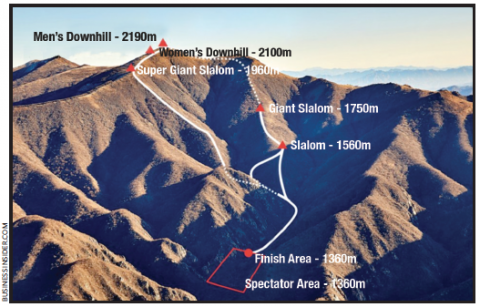
Article Date:
Tuesday, October 6, 2015
China and the future of the Winter Olympics. By John Fry
The transformation of the Olympic Winter Games within the lifetime of most Skiing History readers has been shocking.
The first Winter Olympics after World War II took place in the magical snowcapped Engadine Alps around St. Moritz, Switzerland. The 1952 Games were held in skiing’s historic Norwegian homeland, Oslo, followed by the gorgeous setting of the ’56 Games amid the soaring Dolomite peaks surrounding Cortina d’Ampezzo, Italy. And who can forget the ceremony opening the 1960 Olympics when the clouds parted and the sun, absent for days, shone gloriously down on the pristine snow-capped Sierra Nevada around tiny Squaw Valley?
The early 20th Century’s implicit understanding that snow and cold and mountains would define the location of the Winter Games ended definitively in the
21st Century. Sochi in 2014 (see “After Sochi, What?” in the March-April issue of Skiing History) mirrored the IOC choice of another sea-level city for the 2010 Winter Games, Vancouver, where fog, rain and predictably warm weather on Cypress Mountain and the base of Whistler fogged the ski and snowboard competitions.
The Games—which have tripled from 35 medal events in 1968 to more than a hundred today—have migrated from winter wonderlands to sprawling urban centers. Nothing surpasses the International Olympic Committee’s choice of Beijing (population 11.5 million) as the host city for its 2022 Winter Games. Beijing won by a narrow four-vote margin over Almaty, Kazakhstan’s largest city, ringed by impressive 4,000-meter peaks and favored by most top-level skiers I’ve talked to. Voting countries not engaged in winter sports likely affected the Chinese outcome.
Beijing’s atmosphere is one of the most polluted in a country where, according to the research organization Berkeley Earth, outdoor air pollution contributes to the deaths of 4,400 people daily. Distant coal-burning plants to the southwest of Beijing create much of the vast metropolis’s air pollution, worse in winter.
Fifty-five miles northwest of the Chinese capital is the proposed site of the alpine ski racing competitions in February 2022, Yanqing, a cold, arid, mountainous, treeless desert. The average annual snowfall is five centimeters, about two inches. Arizona’s mountains are lush by comparison.
Gunther Hujara, FIS technical expert, and ski resort planner Paul Mathews of Ecosign, Whistler, BC, have spent time at the proposed Chinese ski venues for 2022. I talked at length with both men. Hujara grudgingly acknowledges that it’s technically possible to hold the races on the rugged south-facing terrain. Massive amounts of water, compressed air and pipes would be required to lay snow all the way to the summit.
“Our job is to make it work,” says Hujara, who adds, however, that he was not shy in expressing to the IOC misgivings about the site selection. Mathews believes the alpine ski events will be shifted elsewhere. “It’s not unusual for venues to be changed after the Games have been awarded,” he observes.
Ecosign has done extensive design work in the Chongli region of China, where the nordic and snowboarding competitions will take place on surfaces entirely
blanketed with machine-made snow. The region is 180 miles northwest of Beijing; high-speed train service will bring it within 50 minutes travel time.
The lack of natural snow, while unattractive to a winter sport aficionado’s eyes, is not functionally bad. Alpine course preparation is difficult if major snowstorms unexpectedly arrive. That’s not going to happen in China, where, at the same time, conditions for making snow are good.
The climate of the region is similar to that of northeastern China, in Heilongjian Province, where I skied with the late Ned Gillette and Jan Reynolds in the winter of 1980 (SKI Magazine, October 1980.) The hills lie east of the vast Gobi desert. The prevailing westerlies don’t pick up moisture until they cross the Sea of Japan and dump snow on Hokkaido and Nagano, hosts to the 1972 and 1998 Winter Olympics.
No significant ski resort existed in China at the time of our pioneering visit, but today Heilonjiang Province is home to China’s most popular and populous ski areas, like Yabuli. The topography and climate are similar to that of Pyeongchang in South Korea, a ski resort region where the Winter Olympics will be held in a little more than two years from now. Preparations for the 2018 Games at one time were months behind schedule.
“We have faced huge problems,” says Hujara. The Koreans failed to budget enough time and money for unforeseen but critically needed infrastructure.
Ever since Grenoble in 1968, IOC-chosen host cities have spent billions of dollars on buildings and highways, and facilities, often with meager after-use. The expense and tax burden of creating massive infrastructure is what has recently deterred potential host cities in Norway, Sweden, Switzerland, France and other countries from bidding for the Games. It has left the field open to Asian nations, like Russia, Kazakhstan and China, with governments that can impose the tax burden on citizens who don’t have access to the ballot to oppose.
By 2022, three Winter Olympics in a row will have taken place outside of the Western world, their birthplace. No one wants them because of their financial and environmental impacts.
To encourage countries to bid again in future, the IOC will look favorably on cities with ready-made competition facilities, places where the Games have previously been held. Host cities will be able to save money by having sports, such as the costly bobsled and luge, held in another country, a possibility envisioned years ago by former IOC member Jean-Claude Killy,
Will the bidding reforms attract Western European or even North American resorts to seek the 2026 Winter Games? Perhaps they will return to the handsome, photogenic mountains of their early years. It remains to be seen.
John Fry is the chairman of the International Skiing History Association, and author of The Story of Modern Skiing (380 pages, available at Amazon).
